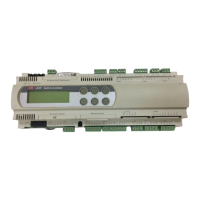Standard Chiller/HP modulare per compressore a vite con driver CAREL
Cod.: +030221241 Rel. 1.0 dated 25 September 03
20
9 ELECTRONIC EXPANSION VALVE
The EV Driver module for piloting the electronic expansion valves (EEV) for the pLAN network, makes it possible to control intake
superheating to enable the refrigerating unit to operate more efficiently and with greater versatility.
We say efficiently, because by improving and stabilising
the flow of refrigerant to the evaporator, we increases the
system's overall performance, while guaranteeing safety
(low pressure pressure switch less frequently tripped,
fewer returns of liquid refrigerant to the compressor,…).
Furthermore, if the EEV is correctly sized, use of
condensation pressure (or evaporation pressure,) either
floating or at low set point, considerably increases the
system's efficiency, while ensuring lower energy
consumption and greater refrigerating yield. It is versatile,
because the electronic expansion valve makes it possible
to serve refrigerating units with a lower refrigerating
capacity and in operating conditions which may differ
considerably from each other.
Using an expansion valve entails the installation not
only of the EVDriver and the expansion valve itself,
but also of a temperature sensor and a pressure
transducer, both located on the refrigerating side at the
end of the evaporator (on the compressor's intake
pipe). Consult the following diagram for a better
understanding of the system's typical lay-out.
The priorities to be considered for optimal control of the refrigerating system: obtaining a high, constant refrigerating yield rather than very low,
stable superheating.
The heart of the control is a PID control with settable coefficients for superheating.
These are the additional controls: LOW (Low superheating with integral time and adjustable threshold)
LOP (Low evaporation pressure, operating in transients only, with integral time and
adjustable threshold)
MOP (High evaporation pressure with integral time and adjustable threshold)
HiT cond (High condensation pressure, enablable only with the condensation pressure probe
read by pCO, with integral time and adjustable threshold)
The parameters table describes the control parameters with thresholds and default values. The table below explains the meaning of the VALVE
TYPE parameter (see screens F1- F2):
PARAMETER VALUE TYPE OF CORRESPONDING VALVE
0 Alco EX5 – EX6
1 Alco EX7
2 Alco EX8
3 Sporlan SEI 0.5 - 11
4 Sporlan SEI 25
5 Sporlan SEI 50 – SHE 250
6 Danfoss ETS 50
7 Danfoss ETS 100
8 ---
9 Carel E2V**P
10 Carel E2V**A
11 Custom (other type of valve)
9.1 DRIVER PARAMETERS
In this section, we shall explain the essential parameters of greatest interest for setting up the driver. The screen code (see chap. "PARAMETERS
LIST") is used (in brackets) to describe these parameters, in order to help you find the appropriate parameter.
Each pCO* card manages a maximum of two drivers. As they have the same configuration, this section illustrates the first driver's configuration
only.
9.1.1 Valve Type and battery presence (F0)
The type of valve and battery presence are set on this first screen. These are the possible valves:
• Alco (EX5, EX6, EX7, EX8)
• Sporlan (SEI 0.5, SEI 1, SEI 2, SEI 3.5, SEI 6, SEI 8,5, SEH 100, SEH 175, SEH 250)
• Danfoss (ETS50, ETS100)
• Carel E2V
• Custom valve (if none of the valves described above are the one used by the user).
9.1.2 EEV circ. percentage ratio (F1)
This indicates the ratio, as a percentage, between the maximum refrigerating capacity of the circuit controlled by the EVDriver and the capacity
obtainable through maximum opening of the expansion valve, under the same operating conditions. Operating conditions are all the system variables
which influence the refrigerating yield of both the system and the valve (condensation temperature, subcooling, superheating, loss of load,….).
Condensor
EEV
Evaporator
Compressor
T probe
P probe
Motor
connection
pLAN
EEV
Evaporator
T probe
P probe
Motor
connection
pLAN

